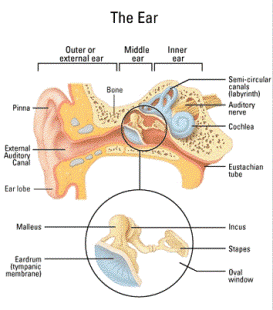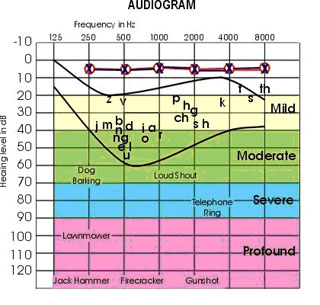Deafness

The human Ear has three parts: the Outer Ear which is the visible outer portion of the ear, the pinna, and ear canal; the Middle Ear of the eardrum and three tiny bones; and the Inner ear of the fluid-filled cochlea, which contains thousands of tiny sound receptors called hair cells.
For people with normal functioning hearing, the outer ear collects the sound waves and directs them to the eardrum. The sound is then changed into a mechanical vibration of the eardrum. This vibration is transmitted to the three tiny bones of the middle ear that transfer the movement to the oval window, a membrane covering the entrance of the cochlea.
Motion of the oval window causes vibrations to ripple through the fluid in the inner ear, or cochlea. The motion of the fluid causes the tens of thousands of hair cells (because of the tiny hairs they have on the top) to move and in turn electrical signals are sent to the hearing nerve, which carries them to the brain where they are interpreted as sound.
Whatever the cause of deafness it usually falls into two main categories, conductive loss, which usually occurs in the middle and outer ear and cochlear hearing loss which involves the inner ear. (There are also other less common causes of hearing loss e.g. neural and central). Hearing loss in both ears is known as bilateral hearing loss or, if in one ear only, as unilateral hearing loss. A child becoming deaf before acquiring speech and language is prelingually deaf. If the hearing loss occurs after speech and language have been established, the child is generally referred to as postlingually deaf.
There are many causes of deafness such as infection, disease, physical trauma and excessive sound exposure. Some children are born deaf, the deafness being hereditary or from the mother’s illness during pregnancy. Children can be born with syndrome deficiencies which can cause deafness.
Whilst normal healthy young people have a hearing frequency range from 20 Hz upto 16,000 Hz, this diminishes with age as the response to the higher frequencies declines. This can become pronounced in older people and is called prebycusis. Deterioration in overall hearing in adults can occur over time and when extensive, it is referred to as Acquired Profound Hearing Loss (APHL).
This can occur over a short period or even quickly when is referred to as Sudden Sensorineural Hearing Loss (SSNHL).
Audiograms

An audiogram is a graph which charts the quietest sounds a person can hear. The graph is represented by frequency (Hz) and sound intensity – loudness (dB). An audiogram is produced by testing the person in a sound treated room, with no other background noise, using pure tones directed through headphones or sound field via speakers. The audiogram does not demonstrate how well a person can understand connected speech. It does give a basic understanding of what a person can or cannot hear through their hearing.
The chart shown here has at the top a line of results which are those of the threshold hearing level of a normally hearing person. The colour bands are labeled with the degrees of hearing loss that can be experienced-Mild (20dB-40dB), Moderate (40dB-70dB), Severe (70dB-90dB) and Profound (90dB plus).
Also shown here are the typical frequencies and loudness levels of vowels and consonants and also other life sounds.
